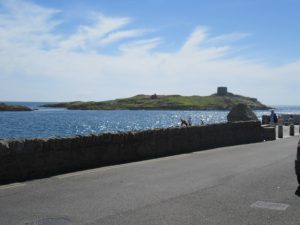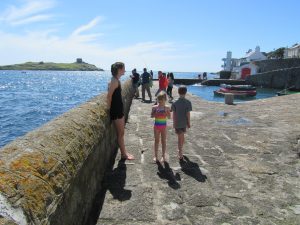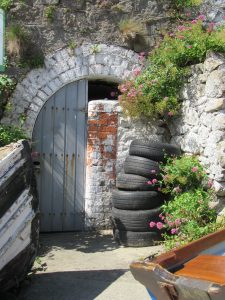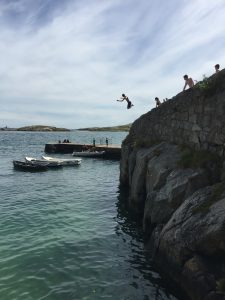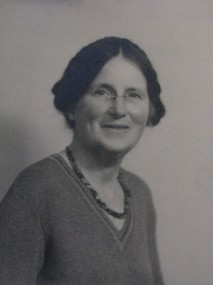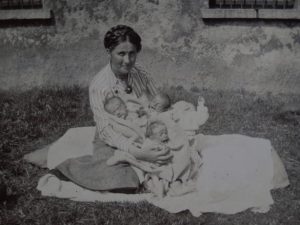Well, if you’re a high school student it is. Do you know how long Amy and Daniel are on holiday for? Three whole months. Twelve weeks. That is just excessive, amigos. Right now we’re at the mid-point. They have already had the equivalent of a full NZ-length summer school holiday and they have another whole one to go. Ridiculous. It should not be allowed until they’re old enough to be made to go down to the SuperValu and get a job. Are you picking up what I’m laying down? By the time school starts they’ll be so used to living the teenage dream of doing absolutely nothing that it’ll take until Christmas to get with the programme again. For the love of God.
One good thing about these overly generous school holidays is that the place is awash with holiday programmes and they all look awesome (although a fair few also look awesomely expensive). There was a Summer Camp Expo at the local fancy-pants hotel a couple of months ago and we all went along and picked up pamphlets (and I got a free massage and little chocolately ball thing from the hippie stall). They call them summer camps although apart from one or two they don’t involve staying overnight, much to Noah’s disappointment. They’re day programmes that run for a week or two, or sometimes you just pick and choose individual days.
The one that Amy was all excited over was the Connemara Maths Academy and it does look like something almost out of this world. There are several variations depending on which outdoor activities appeal most and they’re all in spectacular venues like the stunning Kylemore Abbey.
Amy saw the list of activities:
and the photos on the website:
and read snippets from previous camps:
‘Day 4 CMA Summer Camp July 16-22
Cian kept everyone in track to finish their sound tracks in Music Technology workshops while James ran Challenges and puzzles including the Pythagoras Squares.
Tunnels and Team Tasks followed by Graham’s workshops on electricity and Sine Waves.
Surfing was a big hit! Kevin and his team gave everyone the basics in 5 minutes and then it was off into the Wild Connemara Surf!’
and she wanted to do ALL THE THINGS.
Her preference was the one offering aeronautics and a flight simulator, which would have all been excellent, except that it cost €800. And it was less than a month away. And we would have wanted to send Daniel too because based on all his testing over the years he should be a lot better at maths than he is and we’ve always believed that it’s a matter of finding someone who knows how to teach it in the way that his brain can hear it. If anyone can do it it seems as though the very brainy types that run these camps could. If you spend the morning surfing then the afternoon looking at the mathematics behind waves it seems to me you’ve got a better chance of capturing the interest and imagination of someone like Daniel than your average maths teacher.
But, €1600. Hell no. I see there are kids who go to two or three in a row at the different venues. That is serious disposable income. I am in awe.
After looking through a few more pamphlets Amy settled on a murder-mystery film-making course at the Gaiety School of Acting in the venerable Smock Alley Theatre. She could also have chosen a Vikings themed one (she was tempted; they offered special tuition in stage combat which would obviously come in handy often in her day-to-day life in a house full of siblings) or Wicked, Grease or Hairspray themed musical theatre workshops.
Noah could have done Roald Dahl, Star Wars, Diary of a Wimpy Kid, Beauty and the Beast, Lion King, Witchcraft and Wizardry or Whodunnit themed camps and Cassia could have done Under the Sea, Disney, Adventurers or Storytime Stars workshops, and I did think about putting all three of them in, but then something better came along.
I had been suffering from too many choices for Noah and Cassia. I wanted them to do them all, because they looked so good, but it would have become expensive pretty quickly. Within walking distance there was art camp, Lego camp, drama camp, music camp and a variety of sports camps, as well as a couple of general bit-of-everything camps. Most of them run throughout the holidays so if you had enough cash you could book your children into them all. Josh was worried that I was about to do just that when I went along to their school one morning to find it covered in posters for a two-week summer camp at the Sallynoggin Youth and Community Centre just across the road. It was only open to children from their school and the neighbouring estate, so they would all know each other, and it was very very cheap. Sallynoggin is considered a disadvantaged area and I imagine there was subsidising going on because I can’t see how they could have provided the programme they did otherwise.
So I signed them up, chose Tuesdays for my compulsory once-a-week mother help day because the other days involved bus trips (I have done my time on school buses full of over-excited wee ones, people. Done. My. Time) and counted down the days.
Well, it was great. Mondays, Wednesdays and Fridays were away days where they packed them on a coach and took them to Marlay Park, a great big park full of interesting stuff that we’ve never been to because it’s a long way by public transport; Clonfert Pet Farm in Maynooth (pronounced ‘Minoot’); Airfield Estate; Wells House and Gardens down Wexford way which had a Fairy Forest and a Gruffalo; and on the only wet day in the whole fortnight, the beach. On Tuesdays and Thursdays they did painting and clay, scavenger hunts and ball games, a trip to the pool and a Teddy Bears’ Picnic, a barbeque and general playing. It was run by three ladies who took no nonsense and called everybody ‘lads’ and were generally amazing. I enjoyed my Tuesdays too. Noah and Cassia ran off happily each morning and it didn’t start until ten so we didn’t even need to spoil our holidays by getting up early. Win all around.
Although Amy also loved her theatre camp, it’s imprinted on my memory for entirely different reasons. On the Thursday afternoon of that week the phone rang and the lady said Amy’s hurt herself and can you come please and I swear, if I had a dollar for every time I’ve had that phone call. I had four children with me and was more than an hour away so Josh went. They had been playing bullrush and she tripped and hit a wall hard enough with her face to snap off a front tooth and, although we didn’t realise until later when all the swelling had gone down, break her nose. It was quite a mess although she, used as she is to breaking things, was far more concerned about the possibility of not being able to go to the last day of her workshop. She had scenes still to act in and her group had already re-written them to accommodate her new look (something about a lunatic asylum – details escape me) and she wasn’t bothered at all by looking like she’d been run over by a combine harvester.
As it turned out, after a trip to the dentist she was able to finish her camp. She did spend the weekend lying on the couch though. The tooth couldn’t be capped immediately because of the mess her face was in and she spent a week looking like a pirate, but is back to normal now and we just have to wait and see if the root endures. The nose may need surgery but we’ll cross that bridge when and if.
To be fair, she was due. She broke a bone a year for three years up until last year. As December approached we told her she’d better hurry up or she’d lose her streak. When she said she was going ice-skating with her gym class, I cleared my schedule. Seriously. But she came home intact. Now that she’s done a twofer it covers last year and this year so I can relax because it feels like everything’s as it should be.
Daniel hasn’t done a camp yet, and probably won’t. There is an awesome-looking multi-sport one at Trinity College and I know he’d love it but he’s not one to go on his own. He’d go with a friend but, despite my motherly prodding, hasn’t done anything about trying to organise one to join him. The other kids would all enjoy it too but it’s not cheap and they’ve had their turn. So he’s mostly spending his time lurking around home moaning about whatever I suggest.
Today, though, he wasn’t moaning. At my book club on Wednesday the ladies told me about Coliemore Harbour in Dalkey, only three kilometres from our house. There’s a pier that kids jump off, they said, and I thought, that sounds like us. So when I woke to find the sun splitting the stones I made us all go. Daniel and Josh rode there and the rest of us took a 5-minute bus ride and a 10-minute walk (we don’t have as many bikes as people, you see).
And wasn’t it fabulous. Dublin is a beautiful city, the southern coastal edge where we live is particularly so, and Dalkey is the jewel in the crown. Here is our morning:

Fancy houses they have along Coliemore Road. You can’t see it well in the picture but this one has a gorgeous archy thing there.

This is Dalkey Island. In the Stone Age there was a spear-head making factory there; later it was where they kept their slaves. Now it houses sea birds, a few feral goats and the Martello Tower you can see there.
Then we went to a café in Dalkey for crépes and eggs Benedict. Despite the eternalness of the summer holidays, occasionally the living is easy.
















